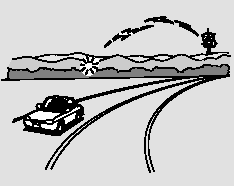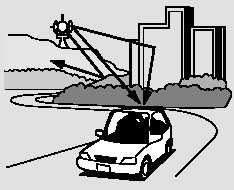AM/FM Radio Reception
Radio Frequencies
The radio can receive the complete AM and FM bands.
Those bands cover these frequencies:
AM band: 530 to 1,710 kHz
FM band: 87.7 to 107.9 MHz
Radio stations on the AM band are assigned frequencies at least 10 kHz apart (530, 540, 550). Stations on the FM band are assigned frequencies at least 0.2 MHz apart (87.9, 88.1, 88.3).
Stations must use these exact frequencies. It is fairly common for stations to round-off the frequency in their advertising, so your radio could display a frequency of 100.9 even though the announcer may identify the station as ‘‘FM101.’’
Radio Reception
How well the radio receives stations is dependent on many factors, such as the distance from the station’s transmitter, nearby large objects, and atmospheric conditions.
A radio station’s signal gets weaker as you get farther away from its transmitter. If you are listening to an AM station, you will notice the sound volume becoming weaker, and the station drifting in and out. If you are listening to an FM station, you will see the stereo indicator flickering off and on as the signal weakens.
Eventually, the stereo indicator will go off and the sound will fade completely as you get out of range of the station’s signal.

Driving very near the transmitter of a station that is broadcasting on a frequency close to the frequency of the station you are listening to can also affect your radio’s reception.
You may temporarily hear both stations, or hear only the station you are close to.

Radio signals, especially on the FM band, are deflected by large objects such as buildings and hills. Your radio then receives both the direct signal from the station’s transmitter, and the deflected signal. This causes the sound to distort or flutter. This is a main cause of poor radio reception in city driving.

Radio reception can be affected by atmospheric conditions such as thunderstorms, high humidity, and even sunspots. You may be able to receive a distant radio station one day and not receive it the next day because of a change in conditions.
Electrical interference from passing vehicles and stationary sources can cause temporary reception problems.
As required by the FCC:
Changes or modifications not expressly approved by the party responsible for compliance could void the user’s authority to operate the equipment.
See also:
Tire Service Life
The life of your tires is dependent on many factors, including driving
habits, road
conditions, vehicle loading, inflation pressure, maintenance history, speed, and
environmental conditions (even ...
To Clear the System
Security codes, paired phones, all stored voice tags, all speed dial entries,
and all imported phonebook data are erased.
1. Press the PHONE button or the
button.
2. Rotate to select Pho ...
Keys and Locks
The master key fits all the locks on your vehicle. The valet key works only in
the ignition and the driver’s door lock. You can keep the glove box locked when
you leave your vehicle and the va ...






